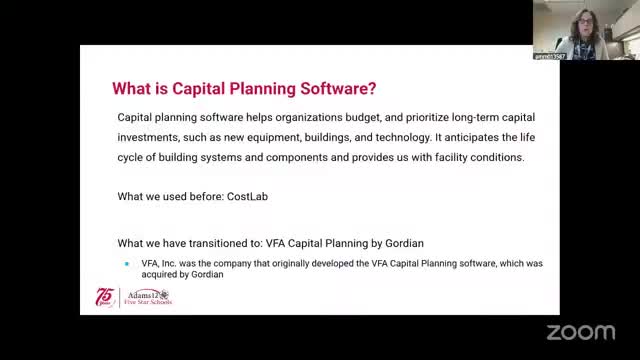Adams 12 staff say new VFA system raises facility needs, ask board to rethink 10% deferred-maintenance threshold
November 21, 2025 | Adams 12 Five Star Schools, School Districts , Colorado
This article was created by AI summarizing key points discussed. AI makes mistakes, so for full details and context, please refer to the video of the full meeting. Please report any errors so we can fix them. Report an error »

District staff told the Adams 12 Five Star Schools Facilities Advisory Committee that switching to VFA, a capital‑planning software now owned by Gordian that uses RSMeans construction‑cost data, yields a more system‑based inventory and substantially higher reported facility needs.
A district staff presenter said the district’s 2024 reporting using the prior CostLab system showed a 14% Facility Condition Index (FCI), with $190,000,000 in deferred maintenance and a total replacement cost of $1,325,000,000. “Using VFA this year … we have a 20% FCI, deferred maintenance of $440,000,000 and a total replacement cost of $2,100,000,000,” the presenter reported, citing the new, more comprehensive inventory and RSMeans‑based pricing.
Molly, who led the board‑policy discussion, told trustees that board policy 2.5.0.2 currently limits projected deferred maintenance to no more than 10% of total facility replacement value. She said the methodological change — system‑level tracking of HVAC, fire alarms, plumbing and site items that CostLab had not included — along with higher construction pricing, means the district likely will not meet the 10% threshold under VFA’s estimates.
“Because our methodology is now different … we do not anticipate being compliant at 10%,” Molly said, and recommended staff and the board align terminology (the presentation noted a preference for the term “deferred maintenance” over “renewal”) and consider moving away from a single percentage target. She and staff proposed exploring alternatives such as reporting by priority or risk category rather than a single lump‑sum percentage.
Board members asked whether the higher totals would change future budgets and bond plans. Staff said the VFA results will inform bond planning but that detailed impacts on the general fund require analysis by finance leadership; staff said planned capital projects — for example, the teardown and rebuild of Thornton High School — will remove roughly $39,000,000 from the deferred‑maintenance total once completed.
Staff also said a subgroup will draft recommendations on policy language and reporting options, which will be taken to LRPAC and then returned to the board for consideration. No policy change or formal vote occurred at the session.
Why it matters: The switch to a more detailed, system‑level cost model can change how a district presents its capital needs to voters, bond counsel and auditors and may affect the timing and sizing of bond requests or other capital funding decisions. The board will decide whether to retain the existing 10% policy, replace it with a different numeric threshold, or adopt a multi‑tier reporting approach that prioritizes critical projects first.
A district staff presenter said the district’s 2024 reporting using the prior CostLab system showed a 14% Facility Condition Index (FCI), with $190,000,000 in deferred maintenance and a total replacement cost of $1,325,000,000. “Using VFA this year … we have a 20% FCI, deferred maintenance of $440,000,000 and a total replacement cost of $2,100,000,000,” the presenter reported, citing the new, more comprehensive inventory and RSMeans‑based pricing.
Molly, who led the board‑policy discussion, told trustees that board policy 2.5.0.2 currently limits projected deferred maintenance to no more than 10% of total facility replacement value. She said the methodological change — system‑level tracking of HVAC, fire alarms, plumbing and site items that CostLab had not included — along with higher construction pricing, means the district likely will not meet the 10% threshold under VFA’s estimates.
“Because our methodology is now different … we do not anticipate being compliant at 10%,” Molly said, and recommended staff and the board align terminology (the presentation noted a preference for the term “deferred maintenance” over “renewal”) and consider moving away from a single percentage target. She and staff proposed exploring alternatives such as reporting by priority or risk category rather than a single lump‑sum percentage.
Board members asked whether the higher totals would change future budgets and bond plans. Staff said the VFA results will inform bond planning but that detailed impacts on the general fund require analysis by finance leadership; staff said planned capital projects — for example, the teardown and rebuild of Thornton High School — will remove roughly $39,000,000 from the deferred‑maintenance total once completed.
Staff also said a subgroup will draft recommendations on policy language and reporting options, which will be taken to LRPAC and then returned to the board for consideration. No policy change or formal vote occurred at the session.
Why it matters: The switch to a more detailed, system‑level cost model can change how a district presents its capital needs to voters, bond counsel and auditors and may affect the timing and sizing of bond requests or other capital funding decisions. The board will decide whether to retain the existing 10% policy, replace it with a different numeric threshold, or adopt a multi‑tier reporting approach that prioritizes critical projects first.
View the Full Meeting & All Its Details
This article offers just a summary. Unlock complete video, transcripts, and insights as a Founder Member.
✓
Watch full, unedited meeting videos
✓
Search every word spoken in unlimited transcripts
✓
AI summaries & real-time alerts (all government levels)
✓
Permanent access to expanding government content
30-day money-back guarantee

